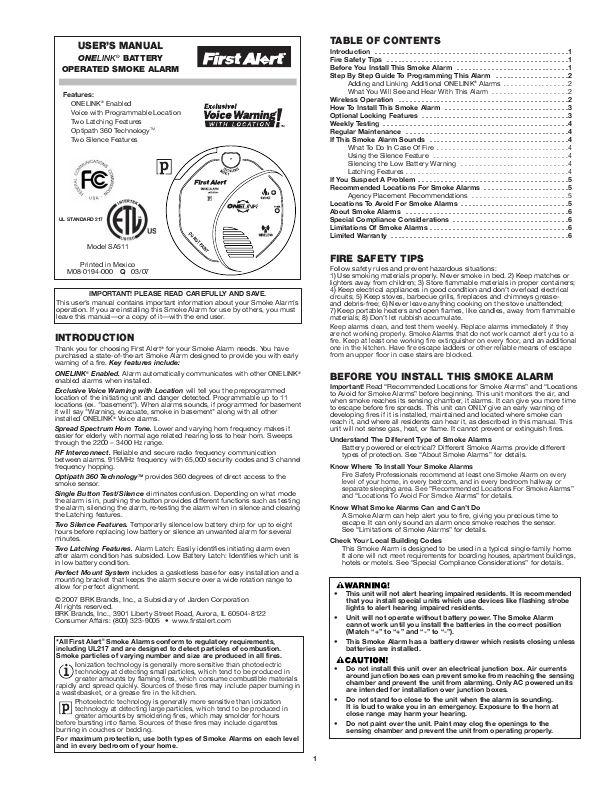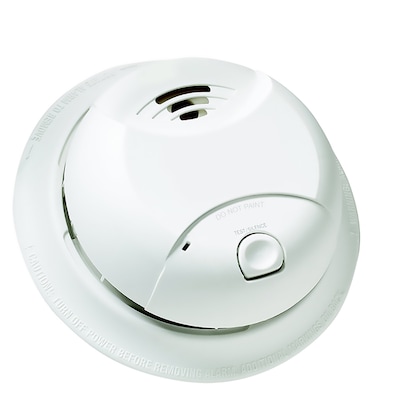IMPORTANT!
First Alert began in 1958, when three friends set out to create a commercial smoke alarm. In the six decades since, we have continued to create innovative products, from the first residential smoke alarm to the first battery operated carbon monoxide alarm. The First Alert BRK SC9120B Hardwired Combination Smoke and Carbon Monoxide Alarm uses an electrochemical CO sensing technology and Ionization sensor for smoke detection. It includes a 9-volt battery for continued function in the event of a power outage, and it features a test/silence button, tamper-resistant locking brackets, and a universal mounting bracket. The First Alert PRC710V Combination Photoelectric Smoke and Carbon Monoxide Alarm with 10-Year Battery and Voice and Location helps protect your home from two potentially deadly threats by providing up to a decade of uninterrupted monitoring. Equipped with dual sensors, this low-profile alarm detects smoke from slow-burning, smoldering fires.
PLEASE READ CAREFULLY AND SAVE.
This user’s manual contains important information about your Smoke
Alarm’s operation. If you are installing this Smoke Alarm for use by
others, you must leave this manual—or a copy of it—with the end user.
USER’S MANUAL
SMOKE ALARM
Printed in Mexico
M08-0067-004 J1
03/07
Models
SA300,
SA303,
SA305
Model SA300
Model SA303 and Model SA305


With Silence Feature
TABLE OF CONTENTS
Fire Safety Tips . . . . . . . . . . . . . . . . . . . . . . . . . . . . . . . . . . . . . . . . . . .1
Before You Install This Smoke Alarm . . . . . . . . . . . . . . . . . . . . . . . . .1
How To Install This Smoke Alarm . . . . . . . . . . . . . . . . . . . . . . . . . . . .2
Optional Locking Features . . . . . . . . . . . . . . . . . . . . . . . . . . . . . . . . .2
Weekly Testing . . . . . . . . . . . . . . . . . . . . . . . . . . . . . . . . . . . . . . . . . . .3
Regular Maintenance . . . . . . . . . . . . . . . . . . . . . . . . . . . . . . . . . . . . . .3
If This Smoke Alarm Sounds . . . . . . . . . . . . . . . . . . . . . . . . . . . . . . . .3
What To Do In Case Of Fire . . . . . . . . . . . . . . . . . . . . . . . . . . . . . . . . .3
Using the Silence Feature (Models SA303, SA305 Only) . . . . . . . . .3
If You Suspect A Problem . . . . . . . . . . . . . . . . . . . . . . . . . . . . . . . . . .3
Limited Warranty . . . . . . . . . . . . . . . . . . . . . . . . . . . . . . . . . . . . . . . . .3
Recommended Locations For Smoke Alarms . . . . . . . . . . . . . . . . .4
Locations To Avoid For Smoke Alarms . . . . . . . . . . . . . . . . . . . . . . .4
About Smoke Alarms . . . . . . . . . . . . . . . . . . . . . . . . . . . . . . . . . . . . . .5
Special Compliance Considerations . . . . . . . . . . . . . . . . . . . . . . . . .5
Limitations Of Smoke Alarms . . . . . . . . . . . . . . . . . . . . . . . . . . . . . . .5
© 2007 BRK Brands, Inc., a subsidiary of Jarden Corporation
3901 Liberty Street Road, Aurora, IL 60504-8122
All rights reserved. Consumer Affairs: (800) 323-9005 • www.firstalert.com
FIRE SAFETY TIPS
Follow safety rules and prevent hazardous situations: 1) Use smoking
materials properly. Never smoke in bed. 2) Keep matches or lighters
away from children; 3) Store flammable materials in proper containers;
4) Keep electrical appliances in good condition and don’t overload elec-
trical circuits; 5) Keep stoves, barbecue grills, fireplaces and chimneys
grease- and debris-free; 6) Never leave anything cooking on the stove
unattended; 7) Keep portable heaters and open flames, like candles,
away from flammable materials; 8) Don’t let rubbish accumulate.
Keep alarms clean, and test them weekly. Replace alarms immediately if
they are not working properly. Smoke Alarms that do not work cannot alert
you to a fire. Keep at least one working fire extinguisher on every floor, and
an additional one in the kitchen. Have fire escape ladders or other reliable
means of escape from an upper floor in case stairs are blocked.
BEFORE YOU INSTALL THIS SMOKE ALARM
IMPORTANT! Read “Recommended Locations for Smoke Alarms” and
“Locations to Avoid for Smoke Alarms” before beginning. This unit mon-
itors the air, and when smoke reaches its sensing chamber, it alarms. It
can give you more time to escape before fire spreads. This unit can
ONLY give an early warning of developing fires if it is installed, main-
tained and located where smoke can reach it, and where all residents
can hear it, as described in this manual. This unit will not sense gas,
heat, or flame. It cannot prevent or extinguish fires.
Understand The Different Type of Smoke Alarms
Battery powered or electrical? Different Smoke Alarms provide
different types of protection. See “About Smoke Alarms” for details.
Know Where To Install Your Smoke Alarms
Fire Safety Professionals recommend at least one Smoke Alarm on every
level of your home, in every bedroom, and in every bedroom hallway or
separate sleeping area. See “Recommended Locations For Smoke
Alarms” and “Locations To Avoid For Smoke Alarms” for details.
Know What Smoke Alarms Can and Can’t Do
A Smoke Alarm can help alert you to fire, giving you precious time to
escape. It can only sound an alarm once smoke reaches the sensor.
See “Limitations of Smoke Alarms” for details.
Check Your Local Building Codes
This Smoke Alarm is designed to be used in a typical single-family
home. It alone will not meet requirements for boarding houses,
apartment buildings, hotels or motels. See “Special Compliance
Considerations” for details.
All First Alert
®
Smoke Alarms conform to regulatory requirements,
including UL217 and are designed to detect particles of combustion.
Smoke particles of varying number and size are produced in all fires.
Brk Smoke Alarm
Ionization technology is generally more sensitive than photoelectric
technology at detecting small particles, which tend to be produced
in greater amounts by flaming fires, which consume combustible
materials rapidly and spread quickly. Sources of these fires may include
paper burning in a wastebasket, or a grease fire in the kitchen.
Photoelectric technology is generally more sensitive than ionization
technology at detecting large particles, which tend to be produced
in greater amounts by smoldering fires, which may smolder for
hours before bursting into flame. Sources of these fires may include
cigarettes burning in couches or bedding.
For maximum protection, use both types of Smoke Alarms on each
level and in every bedroom of your home.
•
This unit will not alert hearing impaired residents. It is recom-
mended that you install special units which use devices like
flashing strobe lights to alert the hearing impaired.
•
Do not connect this unit to any other alarm or auxiliary
device. It is a single-station unit that cannot be linked to other
devices. Connecting anything else to this unit may prevent it
from working properly.
•
Unit will not operate without battery power. The Smoke Alarm
cannot work until you install the battery in the correct
position (Match “+” to “+” and “-” to “-”).
•
This Smoke Alarm has a battery drawer which resists closing
unless a battery is installed. This warns you the unit will not
operate without a battery.
•
Do not install this unit over an electrical junction box. Air cur-
rents around junction boxes can prevent smoke from reaching
the sensing chamber and prevent the unit from alarming. Only
AC powered units are intended for installation over junction
boxes.
•
Do not stand too close to the unit when the alarm is sounding.
It is loud to wake you in an emergency. Exposure to the horn at
close range may harm your hearing.
•
Do not paint over the unit. Paint may clog the openings to the
sensing chamber and prevent the unit from operating properly.
1
UL STANDARD 217